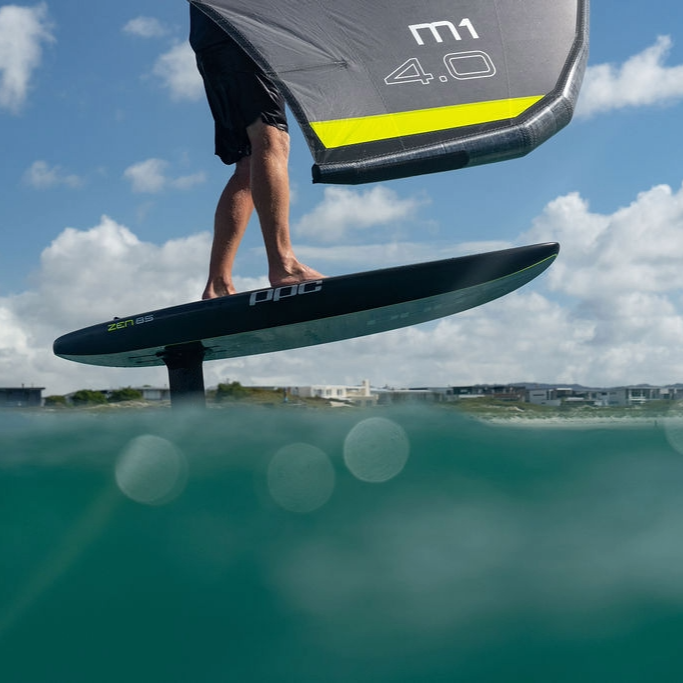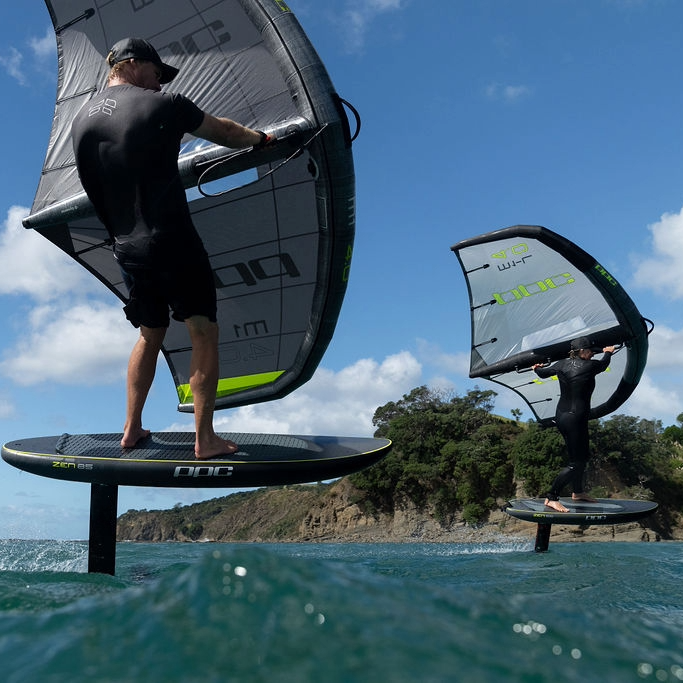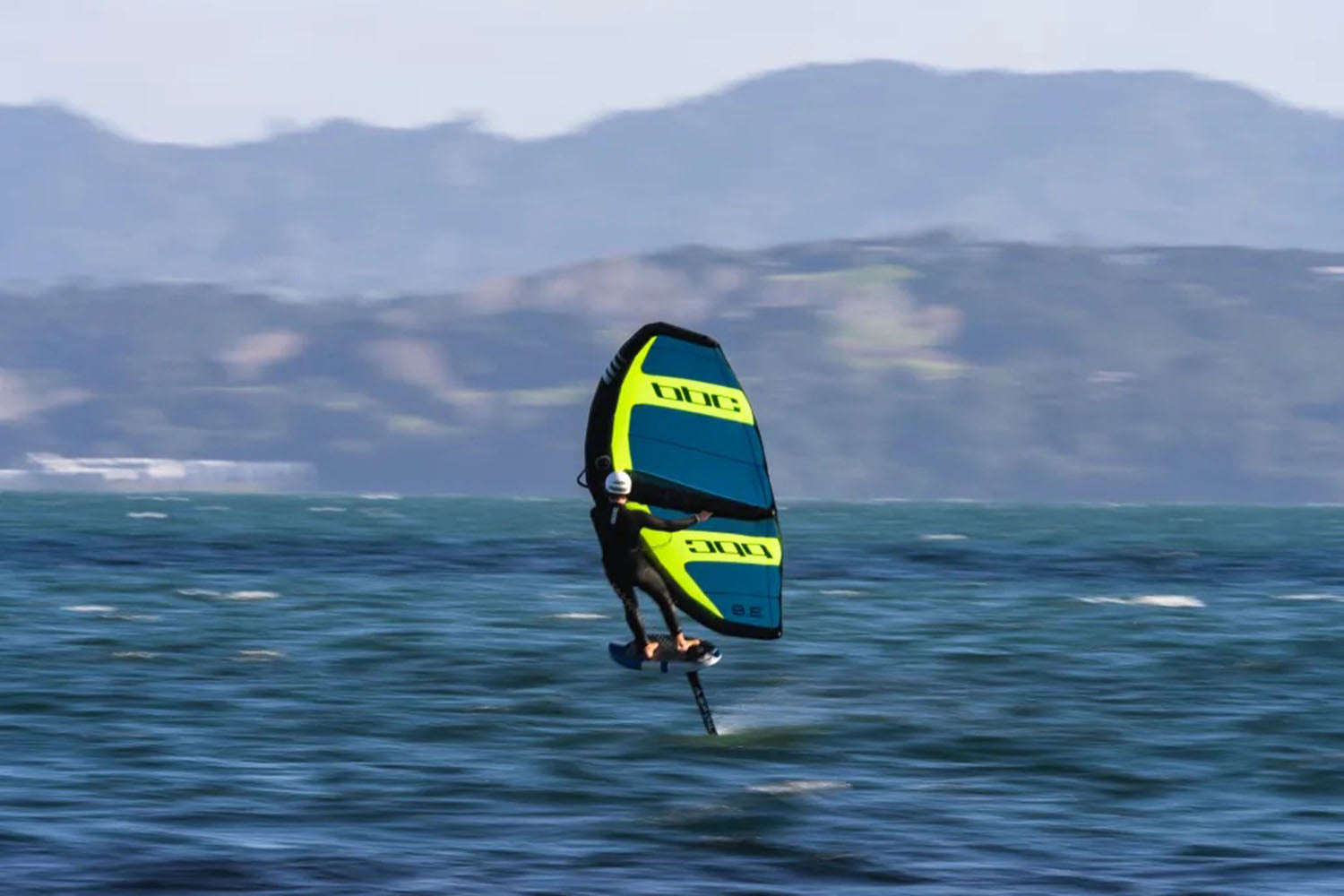What Is Wing Foiling And How Does It Work?
Spotted someone out on the waves holding a wing while their board hovers above the water with a hydrofoil underneath? Then that’s probably Wing Foiling! Want to know what it’s all about and how you can get some of that action? Then you’ve come to the right place – find out everything you need to know about Wing Foiling and more!
What Is Wing Foiling?
Wing Foiling is the latest innovation in board sports. It combines the expertise of riding a short SUP board mounted with a hydrofoil with the thrill of holding a specially designed ‘wing’ that is not attached to the board. Wing Foiling provides the rider with maximum freedom on the water, utilising both the wind and water energy for the ultimate ride.
Not to be confused with Wind Foiling, Kite Foiling, Surf foiling or SUP Foiling, Wing Foiling is different because it uses both the forces of the wind (using the wing) and water (using the foil). The specially designed inflatable wing is used to provide customisable momentum while launching the hydrofoil into action whose aircraft-like design provides lift.
Basic Wing Foiling Terminology
- The inflatable handheld sail-like structure used for propulsion which looks a bit like a hang glider wing crossed with a windsurfer sail but less rigid, and it’s not attached to the board.
- Sometimes referred to as a Foil Board or SUP Foil Board, this is where the rider stands. It is shorter and wider than a traditional SUP board.
- This is the underwater hydrofoil structure that provides the lift when passing through the water. The hydrofoil is basically a wing-shaped underwater fin that provides lift when it reaches the required speed. A hydrofoil significantly reduces drag which in turn increases speed out on the water.
- There are two leashes for connecting both the board and the wing to the rider.
Brief History Of Wings And Foils
Hydrofoils in various forms have been around for over a hundred years. Originally only used on boats, it wasn’t until the 60s and 70s that hydrofoils were trialled on more recreational activities like water skiing and kneeboarding. Driven by the desire to find the best way to play, water sports enthusiasts like Laird Hamilton, Kai Lenny, Mango Carafino, Austin Kalama, Neyl Pride and Robby Naish brought hydrofoiling into the surfing, wind-surfing, and kite surfing arena. From here, the technology has been refined over the years and tweaked to suit the more individualised sports that have emerged like Wind Foiling, Stand Up Paddle Hydrofoiling, Surf Foiling, Kite Foiling and of course; with the addition of the ‘Wing’ – Wing Foiling (in some countries it’s called Wing Surfing).
Speaking of the ‘wing’, the use of handheld sails in water sports dates back to somewhere around the early 1980s. As the hydro foiling technologies advanced, pairing a light handheld inflatable wing was sort of a natural progression, particularly with the growing popularity of the Stand Up Paddle Board. However, early attempts at a ‘kite wing’ were heavy and cumbersome, without any real benefit to the sport. It was only in recent years that the super lightweight and inflatable frames were developed, enabling a more durable and functional design. These days Wing Foiling has grown to be more mainstream, becoming widely accepted as a sport in its own right.
How Does The Hydrofoil Work?
The underlying concepts of the hydrofoil are similar to the design of an aeroplane wing and much like the hydrofoils used in boating and yachting for many many years. The fins (wings) of the hydrofoil are shaped to create lift when passing through the water; the faster the speed, the higher the lift.
Because water is much denser than air, a smaller wing is all that is needed to provide the necessary lift. Under the right conditions, the hydrofoil provides enough lift to raise the rider and board completely clear of the water.
3 Parts Of A Hydrofoil
There are three main parts to the hydrofoil; the mast, fuselage, and the fins (or wings).
- As the name suggests, the mast forms the vertical shaft between the board and the fins. It is usually anywhere from 45cm up to 100 cm in height. The mast creates stability and allows for greater manoeuvrability in the water. Taller masts are best for more advanced riders.
- The fuselage is the middle section of the foil that connects the mast and the front and rear fins. The length of the fuselage affects the riding height and the responsiveness of the ride.
- Fins/Wings. The fins (or wings) of a hydrofoil sit at the front and back of the fuselage. The front wing is the larger of the two and has a shape similar to that of an aeroplane wing; it provides lift by deflecting water downwards as the foil passes through the water. The rear fin provides stability and affects the dynamics of the ride. The front and rear fin can be mixed and matched to customise your ride performance. A smaller rear fin can provide a looser response during turns for more advanced foiling, whereas a larger fin provides more stability for beginners.
Choosing A Foil
When it comes to choosing the best foil for your Wing Foiling kit, it’s a bit of a trade-off between stability, manoeuvrability and agility. Beginners will want more stability, but the more advanced you get, the more you’ll be looking for speed and turning capability, as well as the ability to pump the foil. Here are a few tips on choosing the right foil for you; however, ultimately, you will be guided by your level of progression.
4 Tips On Choosing The Best Foil
- Mast Length. A shorter mast is easier to learn on as it’s more stable; a longer mast adds more manoeuvrability. Aim for around 60 to 80 cm for beginners.
- Fin/Wing Surface Area.The bigger the wing/fin, the more stability, the easier the ride and the more lift it generates. Smaller fins are faster and more manoeuvrable.
- Wing Aspect Ratio. Foil wings or fins have low, medium and high aspect ratios. Low aspect foils have a rounder shape offering more stability. The higher the aspect ratio, the higher the speed and the greater the responsiveness, which means the more difficult the ride.
- Fuselage Length.The greater the distance between the front and back wings, the greater the stability and less sensitive the foil is to movements in height.
How Does The Inflatable Wing Work?
When you first see a Wing Foiling inflatable wing, you’ll find it looks a bit like a windsurfing sail; however it is shaped and constructed quite differently. Wing Foiling wings are extremely light and built around an inflatable framework that needs to be fully inflated to take shape, however, as the sport is still developing, there are some variations on equipment design and some wings may have a physical boom structure to increase structural stiffness.
The inflatable wing works very similarly to a kite or sail in that it provides a collective barrier for the wind as it blows, which causes the wing to lift or pull in the direction the wind is blowing. This pulls the rider and board forward in the direction of the wind.
Choosing A Wing
There are quite a few different brands of Wings available here in NZ, all with slightly different features and benefits. Two of the main contenders are the PPC Surge Wing and the Armstrong A-Wing. Differences might include handle placement, windows or no windows, construction materials, weight and slight differences in the shape of the wing. As you improve and head out in more varied conditions, you may find that having more than one wing offers greater flexibility on the day.
4 Tips On Choosing The Best Wing
- Windows Or No Windows? Yes, the added visibility is great, but windows do add weight. In addition, over time, they may stretch or decay differently to the surrounding material.
- It’s All In The Handles. It is important to match the size and style of the handles to suit your hands while also taking note of the handle placement. You need to be able to keep control of the wing, and this means being able to hold on to it!
- Shape vs Performance. The shape of the wing does have an effect on its performance; the wings are usually defined by their aspect ratio, which is the ratio of the length of the wing over the width of the wing. A low aspect wing is great in gusty conditions providing more stability, and it is smaller, making it easier to handle. A high aspect wing is better for light winds as it works great in low winds and goes upwind really well.
- Perfect Price. Pretty much all of the top brands are around the same price here in NZ. You’ll be looking at $1400 to $1700 for the Armstrong a-Wing (sizes range from 3.5, 4.5 and 5.5 metres) and $1300 to $1600 for the PPC Surge Wing (sizes 2.8, 3.8, 4.8 and 5.8 metres).
What Kind Of Board Is Best?
As with foils and wings, there are a number of different brands of Wing Foiling Boards out there. Some brands make crossover boards that can be used for other foiling sports but generally speaking, you want a dedicated SUP foiling specific board for the best Wing Foiling experience. This shorter, wider and thicker stand up paddle board provides the extra stability needed for the rider to remain upright on the board.
As a general recommendation beginners will want to choose a board 30-40 litres of volume more than their body weight, this provides the much-needed stability when learning to Wing Foil. For example, if you weigh 90 kilograms, you will want a 120 to 130 litre board. As you progress, smaller boards will offer greater manoeuvrability and more of a challenge, but you need to get the hang of it first.
What Is Wing Foiling Like?
Wing Foiling offers water sports enthusiasts an exciting introduction to the epic sensation of hydrofoiling. This challenging water sport will appeal to anyone who loves the water – including surfers, kiters, windsurfers, paddle boarders, and even sailors.
Windsurfers will find it’s a lot less gear to set up and easier to pick up, kiteboarders will love the fact that the gear takes up a lot less space, and there is no need for an assisted launch or landing. For surfers, the drawcard is you can still do it when there are no decent waves or the wind is up.
The great thing about Wing Foiling is it’s easy to learn, low impact and a great workout all in one! Plus, all the gear packs up into relatively little space. This sport is an awesome thrill, and it offers new challenges for all ages out on the water.
How To Learn Wing Foiling
Never tried Wing Foiling before and want to know a few tips to get you started? Read on for our top tips when learning to Wing Foil.
- Practice Handling The Wing On Dry Land. Spending a bit of time on dry land getting used to the handling of the wing is a good idea. Keep practising until you have a good understanding of how it responds to the wind and how changes in hand and body position will affect the wings performance. Check out these introductory videos that will give you some quick basics. Or you can even practice while on a skateboard or snowboard.
- Figure Out How To Carry It All. This may sound silly, but trying to carry a wing that catches the wind and a large foil board together can be tricky. Nobody wants their shiny new equipment all banged up on the first run.
- Practice On A SUP. Have a go with the wing on a plain old Stand Up Paddle Board. This means you can focus on learning how to use the wing before the added complication of the hydrofoil.
- Use Your Wing Foiling Board Behind A Boat. Having a go on your Foil Board while being towed behind a boat can allow you to focus on mastering the dynamics of the board before adding the wing into the mix.
- Get The Wind Right. Strong enough winds are crucial for beginners to get the hang of Wing Foiling. Trying to Wing Foil in light winds is a rookie mistake and makes the wing more difficult to handle requiring a lot of pumping and good technique to get the board onto the foil.
- Take A Lesson. There are some Wing Foiling lessons for all levels available around the country. The cost for a 1 hour lesson is around $300; all of the foiling equipment is provided if you don’t have yours yet or just want to give it a try.

Looking for the best gear for Wing Foiling and want to optimise your foiling experience? Give the guys at the NZ Foil Centre & PPC boards a call today!



